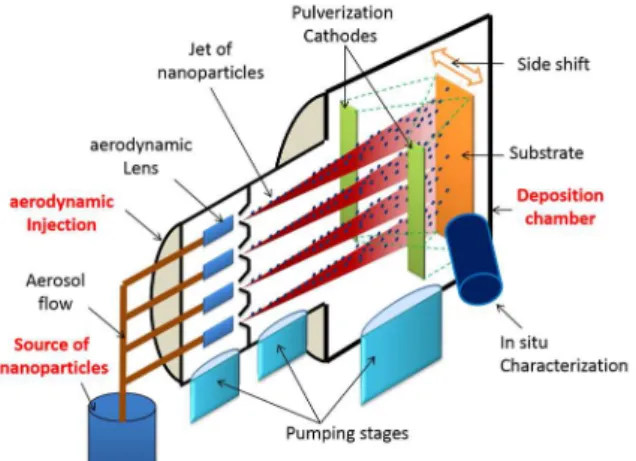HAL Id: cea-02339800
https://hal-cea.archives-ouvertes.fr/cea-02339800
Submitted on 30 Oct 2019
HAL is a multi-disciplinary open access
archive for the deposit and dissemination of
sci-entific research documents, whether they are
pub-lished or not. The documents may come from
teaching and research institutions in France or
abroad, or from public or private research centers.
L’archive ouverte pluridisciplinaire HAL, est
destinée au dépôt et à la diffusion de documents
scientifiques de niveau recherche, publiés ou non,
émanant des établissements d’enseignement et de
recherche français ou étrangers, des laboratoires
publics ou privés.
Aerosol Jets from Multiple Aerodynamic Lenses for
Generic Processing of Nanocomposite Coatings on Large
Surfaces
Olivier Sublemontier, Youri Rousseau, Yann Leconte, Christian Petit, Eric
Monsifrot, Frédéric Perry, Jean-Paul Gaston, Patrick Chapon, Michel
Stchakovsky, Pascal Briois, et al.
To cite this version:
Olivier Sublemontier, Youri Rousseau, Yann Leconte, Christian Petit, Eric Monsifrot, et al.. Aerosol
Jets from Multiple Aerodynamic Lenses for Generic Processing of Nanocomposite Coatings on Large
Surfaces. Aerosol Technology, Jun 2018, Bilbao, Spain. �cea-02339800�
Aerosol Jets from Multiple Aerodynamic Lenses for Generic Processing of
Nanocomposite Coatings on Large Surfaces
O. Sublemontier1, Y. Rousseau1, Y. Leconte1, C. Petit2, E. Monsifrot3, F. Perry3, J-P. Gaston4, P. Chapon4, M.
Stchakovsky4, P. Briois5, A. Billard5 and F. Torrent6
1NIMBE-UMR 3685/CEA/CNRS/Université Paris-Saclay, 91191 Gif-sur-Yvette cedex, France 2 SOCRATE-Industrie, F-25500 Le Bélieu, France
3DEPHIS, F-25450 Etupes, France 4HORIBA-France, F-91120 Palaiseau, FRANCE 5UTBM/FEMTO-ST, F-25200 Montbéliard, FRANCE
6DECAYEUX-STI, F-80390 Saucourt, FRANCE
Keywords: Nanostructured materials, nanostructured coatings, aerosol deposition, aerodynamic lens. Associated conference topics: 1.5
Presenting author email: Olivier.sublemontier@cea.fr We present here an original and safe-by-design method
for the elaboration of nanostructured coatings composed of nanoparticles embedded in a matrix. This versatile single step process operates under vacuum by combining jets of nanoparticles with magnetron sputtering. The chemical nature of nanoparticles and matrix can be chosen independently. Moreover, any source of nanoparticles in the gas phase can be used. For example, nanoparticles can be synthesized in-situ by laser driven pyrolysis [1] or combustion processes. A classical aerosol generator from previously synthesized nanoparticles can also be used.
The proof of concept was completed using a laboratory apparatus. We have developed a new prototype for synthesizing homogenous nanocomposites thin film on surfaces that are large enough for some industrial needs. The general scheme of the apparatus is presented in Fig. 1. The ability to achieve synthesis on large surfaces is provided by the use of a series of four aerodynamic lenses implemented on the prototype set up between the source of nanoparticles and the deposition chamber. The number of aerodynamic lenses is not limited and the process is compatible with very large surfaces by increasing the number of lenses or roll-to roll coating processes on soft substrates. On-line characterization of the film is provided by in situ spectral ellipsometry.
The lenses are composed of successive chambers separated by diaphragms usually used to produce collimated beam of nanoparticles [2]. Numerical and experimental studies have demonstrated divergent and homogenous jet of nanoparticles by adapting the geometry of the lenses. As the speed acquired by the nanoparticles is high [3], their kinetic energy is sufficient to pass through the relatively high pressure (around 0.5 Pa) deposition chamber and get deposited on a substrate at a distance of 30 cm. The pressure in this chamber is adequate for running a classical magnetron sputtering device used to deposit, on the same substrate and at the same time, the material constituting the matrix of the composite film.
The ability to elaborate large and homogenous nanostructured films were investigated with different types of nanoaerosols of different sizes and densities. Samples composed of gold nanoparticles (see Fig. 2) will be shown. Numerous applications are already considered for this type of coatings, including photocatalysis,
photovoltaic solar cells, aesthetic coatings for luxury industry, hard covering for tools or self-healing films. This work is supported by the French National Research Agency (ANR) under contract N° ANR-14-CE07-0036.
Figure 1: General scheme of the co-deposition prototype for large-surfaces.
Figure 2: SEM micrograph of a nanocomposite coating of gold nanoparticles embedded in a silica matrix. [1] Herlin-Boime, N et al. (2004): Encycl. Of
Nanoscience and Nanotechnology, Naiwa Ed, Vol. 10, pp.1-26.
[2] Zhang, X.F. et al. (2004), Aerosol Science and Technology 38, 619.
[3] Sublemontier, O., Kintz, H., Lacour, F. (2011) Kona Powder and Particle Journal 29, 236.
